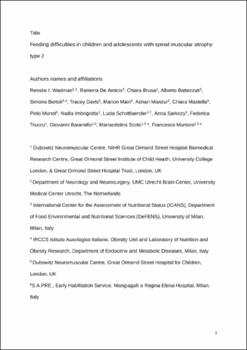| dc.contributor.author | Shottlaender, Lucia. | |
| dc.contributor.author | Wadman, Renske. | |
| dc.contributor.author | De Amicis, Ramona. | |
| dc.contributor.author | Et al. | |
| dc.date.accessioned | 2023-08-14T16:54:43Z | |
| dc.date.available | 2023-08-14T16:54:43Z | |
| dc.date.issued | 2021-02 | |
| dc.identifier.citation | Neuromuscul Disord . 2021 Feb;31(2):101-112. | es |
| dc.identifier.issn | 1873-2364 | |
| dc.identifier.uri | https://riu.austral.edu.ar/handle/123456789/2271 | |
| dc.description | Disponible en: https://www.nmd-journal.com/article/S0960-8966(20)30699-4/fulltext | es |
| dc.description.abstract | Abstract
Disease course of feeding difficulties in spinal muscular atrophy type 2 is not well documented. Disease-modifying therapies rapidly change the trajectory of motor function and survival in spinal muscular atrophy, but effects on co-morbidities like bulbar function are unknown. We analysed data concerning feeding problems and their standard of care treatment in 146 patients with spinal muscular atrophy type 2. Data were collected from two separate cohorts: one single-centre retrospective chart review study from the United Kingdom (London), and one prospective questionnaire-based multicentre study from Italy. Cumulatively feeding difficulties were present in 88 patients (60%) in these 2 cohorts. Median age at onset of problems was 6.5years (range 0-16.5 years). Eighty-two patients (60%) showed periods of underweight according to age adjusted body mass index, and thirty-six patients (25%) showed malnourishment with a significant drop on their weight curves. Enteral feeding was indicated in 23 out of 72 patients in the UK cohort (32%) because of weight loss, oropharyngeal dysphagia or aspiration. Gastrostomy and its placement was generally well tolerated, uncomplicated in 96%, never reversed and performed without Nissen fundoplication in 66% of patients. After gastrostomy chest infections improved in 80% and nutritional status (e.g., Body Mass Index) in 84% of patients. These results show that feeding difficulties are a common problem in spinal muscular atrophy type 2. Treatment strategies should be tailor-made on the symptoms and needs of the individual patient.
Keywords: Feeding difficulties; Nutrition; SMA; Spinal muscular atrophy; Underweight.
Copyright © 2020. Published by Elsevier B.V. | es |
| dc.language.iso | en | es |
| dc.publisher | Elsevier | es |
| dc.rights | Attribution-NonCommercial-NoDerivatives 4.0 Internacional | * |
| dc.rights.uri | http://creativecommons.org/licenses/by-nc-nd/4.0/ | * |
| dc.subject | Feeding difficulties. | es |
| dc.subject | Nutrition. | es |
| dc.subject | Spinal muscular atrophy. | es |
| dc.title | Feeding difficulties in children and adolescents with spinal muscular atrophy type 2 | es |
| dc.type | Article | es |


